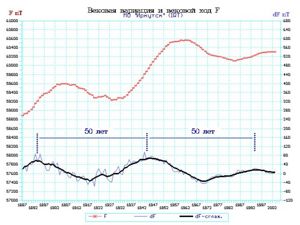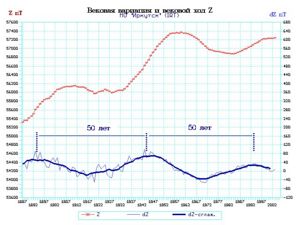Institute of Solar-Terrestrial Physics of Siberian Branch of Russian Academy of Sciences (ISTP SB RAS)
Secular variations of the geomagnetic field
From ISTP SB RAS
Given liquid state of substance in the Earth’s core, geophysicists inferred that the geomagnetic field may be generated mainly as dynamo. Complex convective and electromagnetic processes deep inside the Earth should affect the main magnetic field on the Earth’s surface. Regular continuous measurements of the geomagnetic field have for long been made at the worldwide network of magnetic observatories. The Magnetic Observatory “Irkutsk” started making such measurements in 1887.
A series of average annual values of the geomagnetic field determines its secular variation. Difference between average annual values is referred to as the secular variation allowing us to estimate rate of the field change at different periods.
|
Vector of the geomagnetic field F is usually presented by 3 components: horizontal (H), vertical (Z) and declination (D) components. Declination is the clockwise angle between the horizontal component of the geomagnetic field and the geographic north line. |
|
Secular variation of D shows that the magnetic meridian in Irkutsk has shifted from +2º 13’ to –2º 22’ relative to the geographic meridian over the last 116 years. The magnetic compass needle pointed the geographic North Pole only in 1932. Secular variation of D has not yet revealed any periodic process. Abrupt changes in the secular variation (1921 – 1931) may be caused by the measurement errors resulting from the fact that many specialists were laid off for political reasons. |
|
The diagram presents both wave-like increase in full vector F by 1700 nT and periodicity of the F secular variation with the period of 50 years. This conclusion is borne out by measurements of vertical component Z which is a part of vector F (see diagram 3). Short-term changes in the secular variation before 1947 were mainly due to instrumental errors in dip-needles and induction inclinometers. |
|
Secular variation of the horizontal component shows gradual wave-like decrease in Н by 1250 nT; preliminary estimate of the period of the Н secular variation is 80 years. If we go on observations of the geomagnetic field, this assumption will be either substantiated or disproved in the next century. Changes in the Н secular variation depend mainly on the number of magnetic storms within a year (i.e., they are related to solar activity). |
- This page has been accessed 3,892 times.



